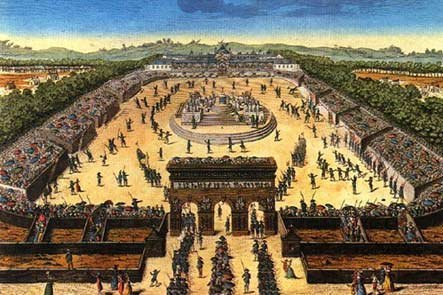14th of July (Bastille Day)

Almost every country has a national celebration, generally chosen to commemorate an anniversary deemed particularly influential and solemn, and nothing is more revealing about a country’s past than the decisions made surrounding this day and how they have changed with the times.
► Behind the scenes of the parades | The French people meet their armed forces
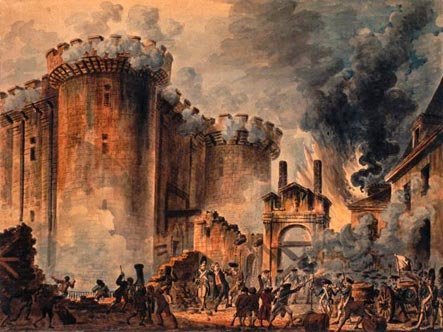
Storming of the Bastille, painting by Jean-Pierre Houël (1735-1813). Source: public domain
In France, the 14th of July – le quatorze juillet, or Bastille Day as it is known in the English-speaking world – commemorates the nation’s shift from a monarchy to a republic and symbolises the fraternal union of every region of France and all French citizens with liberty and equality. An incarnation of national unity, today it combines ceremonious military parades with public dances and fireworks.
14 July 1789: The storming of the Bastille
“-But is it a revolt? -No, Sire, it’s a revolution!” Breteuil to King Louis XVI
The history of the 14th of July begins, of course, with the storming of the Bastille on 14th July, 1789. The rioters, feeling threatened by the king’s troops, came to look for weapons at the Bastille and stormed the prison, seen as a symbol of absolutist power. The 14th of July 1789 marks the first expression of the French people’s wish to obtain their liberty and civic emancipation. Yet the revolutionaries did not stop there; through the Declaration of the Rights of Man and of the Citizen, they rendered the Revolution universal.
The Fête de la Fédération panorama Source: public domain
14 July 1790: The Fête de la Fédération
On 14th July 1790, the Fête de la Fédération held just as much symbolism that day as the year before. This first anniversary celebrated at the Champ de Mars in the presence of King Louis XVI was attended by 30,000 people visiting from all over France. Everybody swore to be forever faithful "to the Nation, to the Law, to the King." The feast day above all showed an aspiration for a new union and a revision of the Nation, based on the values of 1789 and the Declaration of the Rights of Man and of the Citizen.
The Revolution and the world
The French Revolution set off a wave of reactions around the world. For the first time, the man in the street was at the frontline and the new Republic was founded on this principle. In the colonies, the Declaration of the Rights of Man implied the emancipation and abolition of slavery. In Europe, it signalled the start of a new era of emancipation. The Napoleonic conquest, in spite of its abuses, also propagated throughout Europe the ideas of liberty and equality and the right to self-determination.
The political victory of 18 Brumaire (November 1799) followed by the great military successes of spring 1800, prompted the First Consul to designate the 14th of July as a celebration of concord and conciliation. The 14th of July 1799 was no longer the day of ‘liberty’ but was renamed the day of concord. In 1800, the consular guard paraded from the Tuileries gardens to the Champ de Mars. It celebrated not the Storming of the Bastille but the 10th anniversary of the Federation and was centred around the victorious Republican army. 1801 saw the first change to the festivities taking place on the 14th of July. The location was moved from the Champ de Mars to between Place de la Concorde and the far end of the Champs Elysées. In 1802, the 15th of August became a special celebration – St Napoleon’s Day – celebrated with a Te Deum at Notre Dame. The following Bastille Days held less and less significance until, in 1805, the 14th of July was no longer even commemorated.
The Restoration
After 1814, the restored Bourbons banned the 14th of July while ensuring the social conquests of the revolution were enshrined in the Constitution. The monarchic symbolism was based around the Feast of St Louis, on 25th August, and the legend of King Henry IV. Opponents to the monarchy—republicans, liberals and Bonepartists—continued to look to the 14th of July as a day of celebration.
The Trois Glorieuses (the French Revolution that took place on 27th, 28th and 29th July 1830) and the Revolution of February 1848 became part of a Europe-wide, national and liberal revolutionary movement. The expression "the United States of Europe" was uttered first by Victor Hugo who in 1850 declared: "A day will come when we shall see those two immense groups, the United States of America and the United States of Europe, stretching out their hands across the sea".
The Third Republic and the 14th of July 1880
It was not truly until the arrival of the Third Republic, in 1880, that the 14th of July became France’s national day of celebration. After long discussions and despite the tenacious opposition of their adversaries, the Republicans decided to adopt the date that symbolised the Third Republic’s attachment with the French Revolution and enshrined a regime. "Unique Article. - The Republic adopts the 14th of July as the day of its annual national celebration.
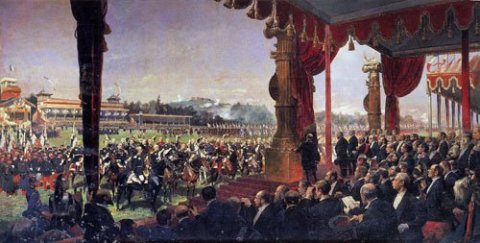
La remise des nouveaux drapeaux aux divers corps de troupe le 14 juillet 1880. Source: Musée de l'Armée
The 14th of July in 1880 allowed the Republicans to combine the reference to the French Revolution and patriotism (reinstatement of the army’s flags). The period that followed saw France rebuild its military forces and resist Germany and, for some, prepare the reprisal. Political differences gradually waned despite flaring up in times of crisis (Boulangism, the Dreyfus Affair).
The 14th of Julys towards the end of this century were some of the most sumptuous ever celebrated in France before. The military review, held in Longchamp, gradually became the centrepiece of the ceremony. The streets around the towns were decked with flags while the festivities culminated with public dances and fireworks. During this period, a number of symbolic events that took place are worth noting: In 1889, for example, the country celebrated the centenary of the French Revolution combined with the success of the Universal Exposition. The construction of the Eiffel Tower perpetuated this memory.
Before 1914
On the eve of the First World War, despite the ideological differences and oppositions that persisted (notably the emergence of the socialist movement), a certain unanimity progressively brought the nation together. Republican France, proud of its past and the efforts of recovery undertaken over the preceding 40 years, confronted the trials ahead in a spirit of national cohesion.
1914-1918, the 14th of July and the First World War
The ‘Great War’ showed the French fighting almost unanimously to defend their fatherland, which was for many inseparable from the Republic. The soldiers heading off to war believed it would be last time such a cataclysm would take place. Charles Péguy, who fell in September 1914, wrote about his departure for the front: "I leave, a soldier of the Republic, in favour of the general disarmament and the end of war".
Many of the men who enlisted in France left with the idea that the war would be short-lived, a belief they shared with their enemies. In actual fact, the conflict would be nothing of the sort. Amongst these events, the 14th of July during the Great War was a moment for an armed France to express, in the sacred union, its desire to defend itself against the invader. In this fight for the Republic, the memory of ‘An II’ (1793 and 1794) and the great ancestors was called to mind, notably on 14th of July 1915, marked by the transfer of the ashes of French army office Claude Josephe Rouget de Lisle to the Invalides, alongside Napoleon, in the ‘Caveau des Gouverneaurs’. The procession started at the Arc de Triomphe, descended the Champs-Élysées and crossed the Seine to arrive at the Invalides. On this date, the heart of Gambetta was also moved to the Pantheon.
Following the Armistice of 11th November 1918, the main peace treaty that concluded four years of global warfare was signed in Versailles on 28th June 1919. The humiliation of 1871 was symbolically "washed away". The humiliation of 1871 was symbolically "washed away". Furthermore, it was decided that a victory parade would be held on the 14th of July 1919.
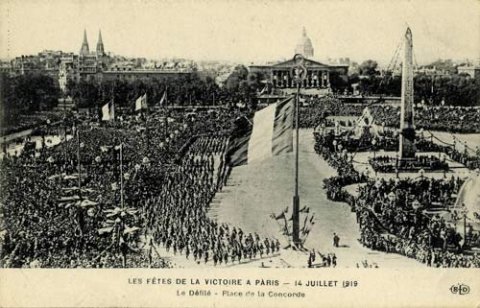
The victory celebrations in Paris – 14th July 1919 – The parade – Place de la Concorde. Source: postcard
The Fête de la Victoire
"Qui a vu ce jour a vécu" (Who saw that day survived) said Clemenceau to Marshal Pétain, on the evening of the 14th of July 1919.
On 14th July 1919, the French army paraded, accompanied by the allied forces’ detachments. At the head of the parade, two men symbolised this victory: Marshals Joffre and Foch. Both war heroes represented France’s will to resist invasion and fight for victory.
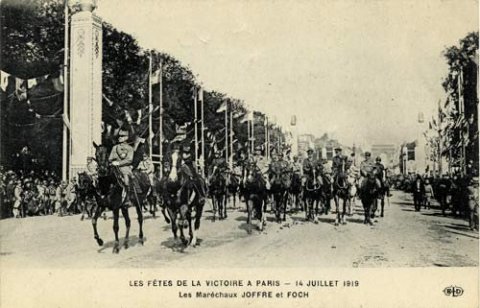
The victory celebrations in Paris – 14th July 1919 – Marshals Joffre and Foch. Source: postcard
The administration of the Académie des Beaux-arts, in charge of decorations, transformed the Concorde-Étoile junction into the Triumphal Way with an antiquity-themed décor featuring burning urns dedicated to the battered towns and Gallic roosters perched on rows of German cannons, masts, standards, badges, pylons and garlands of foliage. This parade paid homage to a thousand individuals killed by war, symbols of the sacrifices made by the French people. Next, all the allied armies paraded in alphabetical order in a procession that lasted for three hours. Led by Pétain, the French army closed the parade.
For the participants and the spectators who represented French public opinion, on this day France wanted to show, through the sacrifices made and the harsh warfare that would enduringly mark the flesh and spirit of its fatherland, the triumph of the democratic Republic over the attempted enslavement of its nation by the German empire.
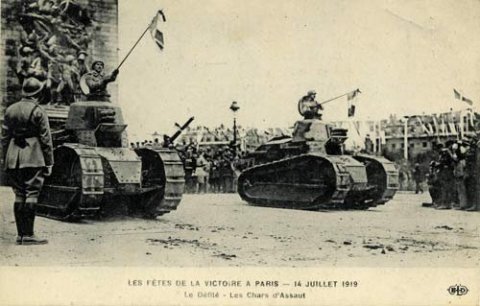
The Victory celebrations in Paris – 14th July 1919 – The parade - Tanks. Source: postcard
The interwar period
Between the two world wars, victorious France rapidly became disillusioned. The war losses had left their mark on the French people. Patriotism was accompanied by a peaceful, even pacifist, spirit. At the same time, the prosperity that changed into economic crisis and the dangers that re-emerged in Europe caused division, in some cases seriously, among the French. Some rejected the ideas expounded in 1789 while others rediscovered the force of the country’s revolutionary past. The French left strongly reasserted the origins of democracy and the Republic.
On 14th July 1936, the Popular Front enjoyed a jubilant victory when it signed the Matignon Agreements. At Place de la Nation, Daladier saluted "our great ancestors who, by their sacrifice, earned the right to inscribe at the French borders: The land of liberty begins here!"
The 14th of July 1939 celebrated the 150th anniversary of the Storming of the Bastille. Threatened by external dangers, France celebrated the day as a symbol of national unity under the illusion of seeing the “world’s finest army” parade.
In a message addressed to France on 14th July 1939, the President of the Republic, Albert Lebrun, proclaimed the lessons learned by the Federation: "May this great evocation bestow us with the strong will to defend the fatherland with all our force, to maintain and pass on to our children the values of liberty and equality, and to live closely and fraternally unity in a free, generous and strong community…"
1940-1945: From the abyss to newfound liberty
France’s defeat in 1940 provided an occasion for some, in a climate of chaos, to radically challenge the Republic and the values it upheld. Marshal Pétain’s government named the 14th of July as a day of remembrance for the nation’s mourning.
The French government that was established under Pétain’s authority founded its national revolution on duty and hierarchy. The regime made do with the defeat and the national debasement that they believed to be definitive. Its aim was to create an ideal France linked with the nation’s past prior to 1789 while agreeing to be accepted into Nazi Europe.
The country witnessed a radical transformation of its repository of symbols. Work Family Fatherland replaced Liberty Equality Fraternity. The Gallic helmet replaced the Phrygian bonnet and the francisc the bundles of the lictors on stamps and official medals.
However, General de Gaulle called for the fight to continue. "The 14th of July does not only mark the great pain of the fatherland. It is also the day of a promise that every French person must make by every means at their disposal, to resist the enemy, momentarily triumphant, so that France, the real France, can be present in the victory". De Gaulle laid a wreath at the statue of Marshal Foch, in London, and inspected the first contingents of the French Free Forces.
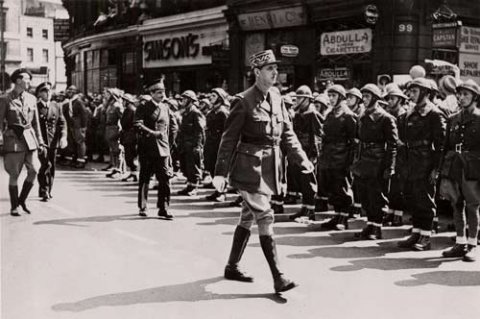
London, 14th July 1940, General de Gaulle inspecting the first volunteers of the Free French Forces. Source: SHD
For de Gaulle, France had merely lost the battle. The war was a world war. The general sought to re-establish France’s independence and greatness. This battle, at first on a national scale, encompassed the fight to restore the Republic’s values of liberty and fraternity. For General de Gaulle, it had never ceased being so and the Vichy regime was thus invalid. The resistors also took up the tradition of fighting for an oppressed nation and the values of human dignity against the Nazi regime that sought to negate all forms of humanism. During the occupation, the 14th of Julys, especially those in 1943 and 1944, were the opportunity for the general population to celebrate victory and liberty.
The victory of 1945
“More than ever a national celebration since France is celebrating its victory at the same time as its liberty" General de Gaulle, 1945
The 14th of July 1945 was in fact a three-day celebration filled with public rejoicing. The eve of 13th July was a solemn celebration. A splendid flash of lightening burst out under the Arc de Triomphe.
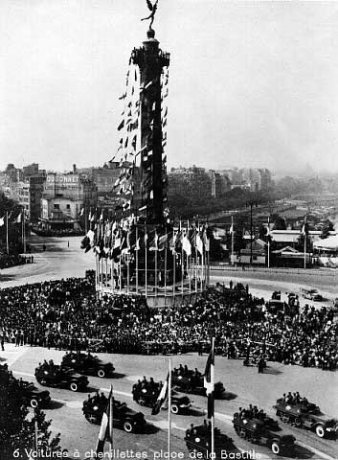
14th of July celebration 3p.m. Paris. Tracked vehicles at Place de la Bastille. Photo MINDEF/SGA/DMPA
This 14th of July, as memorable as this day in 1919, allowed the nation to establish the triumph of its democracy over the Nazi dictatorship. Along the procession route, thousands of people came to applaud the French and the British and American allies. The parade travelled from Place de la Nation to Place de la Bastille and then continued on to the Arc de Triumphe. The troops were then inspected by General de Gaulle. The press described the fête de la fédération celebration as the “celebration of the first resistance”.
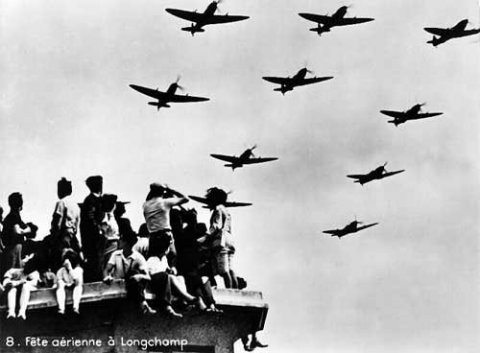
14th of July celebration 3p.m. Paris. Aerial display at Longchamp. Photo MINDEF/SGA/DMPA
The Fourth Republic
During the Fourth Republic, the 14th of July continued to be commemorated as a tribute to liberty and emancipation, but also as a celebration of the army, engaged in two world wars that sprang from the tragic process of decolonisation. some feared and condemned the anti-colonialist stance they considered to be a “selling off” of the Empire and France’s greatness in the face of “communist subversion”, while others, remembering the values of emancipation upheld by French Revolution, notably symbolised by the 14th of July, wished to see the end of these colonial wars and the start of independence for the colonised populations.
The Fifth Republic
The government’s instability provoked by the Algerian war brought General de Gaulle back to power and founded the Fifth Republic.
The 14th of July in 1958 and in 1959 were designed to dazzle. France, while being allied to the United States, wished to assert its identity and its independence. On the 14th of July in both years, heavy arms were paraded for the first time. The procession became a showcase of French military power.
The national celebration then adopted a political aspect opposing the parties on the left with those on the right. Two celebrations overlapped, a Gaullist 14th of July and another anti-Gaullist. The two 14th of Julys in 1958 and 1959 referred to the national celebrations of the past. The right and the left claimed to be followers of the “legend” of the 14th of July. So, on the one hand, the years 1789 and 1936 were used as references to combat the Gaullist power. While on the other, to 1789 and above all the Federation to encourage the citizens to come together in support of the head of State.
President Giscard d'Estaing attempted to symbolically recover certain 14th of July traditions, in particular by re-establishing the parade route from Bastille to Republique.
The arrival of François Mitterrand to the Presidency of the Republic in 1981 and above all the celebration of the bicentenary of the French Revolution of 1789 brought back a spirit of revival to 'Bastille Day' by exalting the founding values which, born in France, were now proclaimed by a Europe in construction and, more generally, by western civilisation. This was supported by the presence of the President of the US and European and African leaders to the ceremonies of the 14th of July 1989.
To an international 14th of July: 14th of July today
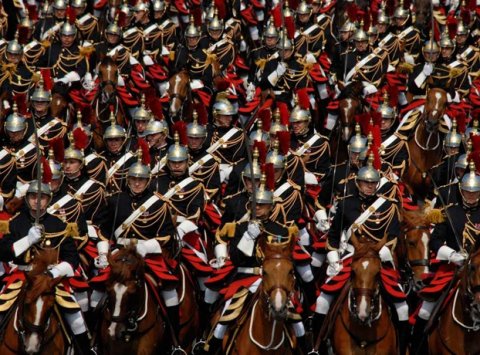
Parade of 14th July 2006 – Republic guard cavalry (75) Source: Photo Jacques Robert
The 14th of July today is considered a symbol of national unity founded on the shared values upheld by the Republic. It is also the occasion to applaud these values in peace with our European friends and those who share a common history with us. Thus, on the 14th of July 1994 the Eurocorps joined the procession and on the 14th of July 1999, to celebrate the year of Morocco, King Hassan II attended the parade which also saw a detachment of the Moroccan guard participate.
After being a symbol and a theme of history, the 14th of July is today a representation of the values of liberty, equality and fraternity or, in brief, of human rights and dignity.
Bibliography
Publications
Les lieux de mémoire, Sous la direction de Pierre Nora, Quarto Gallimard, 1997
Les 14 juillet, fête et conscience nationale. 1789-1975, Rosemonde Sanson, collection tradition et le quotidien, Flammarion 1976
Histoire des 14 juillet 1789-1919, Jean Pierre Bois, édition Ouest France Université, Rennes 1991
La République en fête : les 14 juillet, Pascal Ory, catalogue de l'exposition Bibliothèque Publique d'Information. 2 July- 6 October 1980
Le 14 Juillet, Lucien Vogel, Paris, Office française d'édition, 1945
Images de La Révolution, Jean Garrigues, éditions DuMay-BDIC, 1989
Le Dictionnaire critique de la Révolution française, F. Furet et M. Ozouf, Flammarion 1988
L'histoire de la Révolution Française, Jules Michelet, 1847
Histoire Socialiste de la Révolution Française, Jean Jaurès, 1924
Articles
Le premier 14 juillet de la République, 1880 Mona Ozouf, L'Histoire n°25, Juillet-Aout 1980


